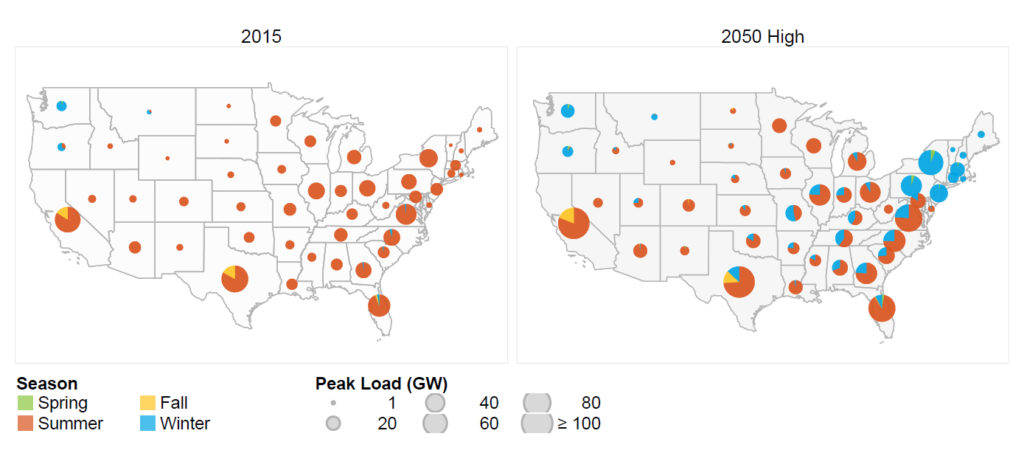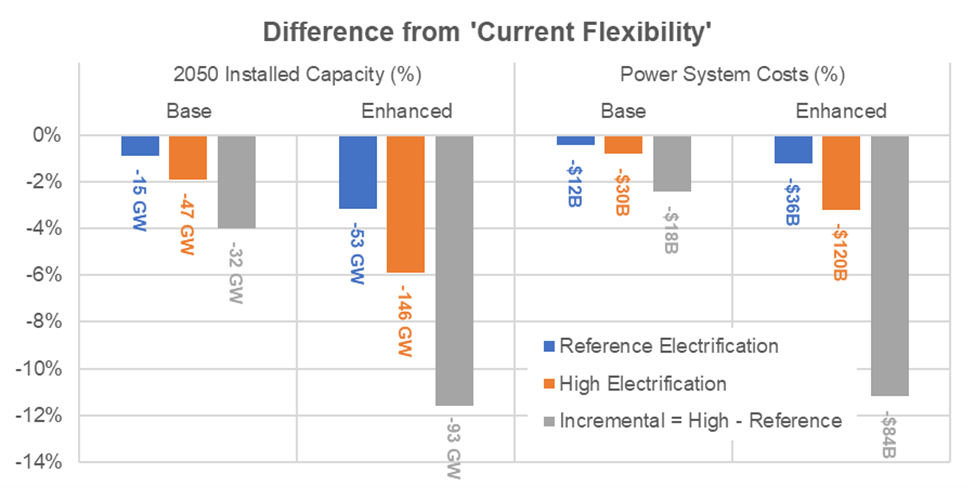Evolving Electricity Supply and Demand
Electrification of end uses and the decarbonization of electricity supply are among the key strategies in the broader transition to economy-wide decarbonization. Each one is rooted in separate parts of the energy system, but they are inherently linked. As electricity is increasingly used to meet energy demands within residential and commercial buildings, industry, and transportation, the amount and timing of electricity use will change. Annual demand for electricity will increase, and the magnitude and timing of peak electricity demand will evolve, particularly in regions where space heating is increasingly electrified. For example, many recent studies point to the potential for the Northeastern United States to become a winter-peaking region in scenarios with widespread adoption of cold-climate heat pumps for space heating applications (Figure 1).

Figure 1. The magnitude and timing of peak electricity demand is expected to evolve under widespread electrification, with some states transitioning to winter peaking (right).
These changes in electricity demand will occur concurrently with an evolving electricity supply mix, driven by cost and performance improvements, policies, and regulations. Higher demand peaks and shifts in their timing across the year will influence planning for new supply assets. They could also shift the competitiveness of various low-emitting sources of electricity supply. Both the electricity supply and demand sectors have characteristics that can help mitigate these challenges.
The Role of Flexibility
Flexibility in electricity supply and demand make important contributions to grid reliability. Natural gas–fired and energy-storage technologies are often relied upon for rapid responses to maintain supply-demand balance. Flexible loads contribute via peak shaving, which is typically realized through demand response programs for grid-connected water heating (longer duration) and space conditioning (shorter duration). In particular, flexible loads are “dispatched” to shift demand away from high-stress periods and into times when low-cost generation is available (e.g., periods with excess variable renewable generation or low utilization factors for thermal generators).
The role of flexible loads in the future will depend on a variety of factors, such as the nature of flexibility (e.g., load shifting vs. load shedding), the underlying generation mix (e.g., the penetration of variable resources), and transmission and distribution (T&D) loading. Recent analyses consistently point to the benefits of demand-side flexibility in an increasingly electrified and decarbonized economy. This is especially true in terms of its role in containing the rise of peak demand and the costs associated with economy-wide decarbonization—including production costs and consumer energy bills. In particular, flexible loads can help avoid the use of high-operating-cost generation, renewable curtailment and system ramps, investments in new generation capacity (Figure 2), and costly upgrades on the T&D networks. When combined with aggressive decarbonization policies, flexible loads can also facilitate emissions reductions at an accelerated pace and lower cost. Finally, demand-side flexibility can make important contributions to reliability and reducing per-unit electricity costs, particularly when combined with widespread electrification. The value of this flexibility to the bulk power system is estimated to be on the order of $10-$20/MWh (Figure 2), although preliminary research indicates that there may be diminishing savings with increasing levels of demand-side flexibility.

Figure 2. Increasing levels of demand-side flexibility can help avoid investments in new generation capacity, and its influence grows with higher levels of electrification.
These potential benefits of demand-side flexibility under increasing electrification are often attributed to large-scale and long-duration sources of flexibility, such as electric vehicle charging, electric boilers, and electrolysis. However, more dispersed sources of load flexibility can help mitigate otherwise-necessary distribution network upgrades and price spikes due to short-duration peak demand events, which are costly for both the power system and customers.
Flexibility in Buildings
The flexibility attributed to residential and commercial building loads is typically under-represented in energy sector models. Many of the building loads that are (or could readily be) captured in existing models are either inflexible or small, due to their high efficiency or low service demand requirements. However, flexible building loads that are not typically represented in power sector models (e.g., thermal storage) can serve as a significant source of flexibility, both in terms of their magnitude (kilowatts) and duration. In addition, managed electric vehicle charging is typically labeled as flexibility within the “transportation sector,” but it must also be considered within the context of other loads within the buildings (residences and workplaces) where that charging occurs.
As a result of these modeling limitations, studies typically assume that only electric water heating applications are large and flexible enough to influence investment and operational decisions on the bulk power system. However, programs that support the flexibility of building loads more broadly can play a key role in reducing peaks and stress on the grid, especially when combined with efforts to reduce overall winter loads (e.g., residential weatherization and more-efficient heat pump technologies). When applied to electric space heating in particular, such programs may be critical for mitigating costly upgrades on the distribution network while also providing consumer benefits in the form of additional revenue streams.
Open Questions Related to Demand-side Flexibility
While potential benefits have been identified for flexible loads, there are still many open questions and challenges to overcome:
-
- Additional research is needed to understand the unique roles of and competition between different sources of flexibility. This includes flexibility in the timing of electricity demand, energy storage options with shorter to seasonal duration, thermal energy storage (in buildings and on the grid), and institutional practices that increase system flexibility.
- We need better estimates of the potential for greater demand flexibility in the buildings sector. This includes customer participation, flexibility duration by service demand category, multi-day demand response, and a breakdown of the timing and magnitude of flexibility from residential and commercial buildings. Similarly, we need better information about how load shifting impacts total electricity demand—especially for services whose efficiency is temperature dependent (e.g., pre-cooling)—and about the tradeoffs between flexibility and improved energy efficiency in buildings.
- In order to evaluate the competitiveness of demand-side flexibility, existing estimates of its value must be compared against the associated costs of both enabling and realizing that flexibility. For example, flexible loads can only be leveraged when households, businesses, and others can communicate with wholesale and local power markets in real time; this requires investment in electricity meters with advanced two-way communications capabilities (which inherently requires broadband access).
- Strategies are needed to overcome technical and institutional barriers to enabling demand-side flexibility. Expanded automation and controls can help realize load flexibility that minimizes distribution network expansion, while a better representation of flexible loads in distribution system planning could help quantify their contributions to improved asset utilization.

Closing Thoughts
Increasing flexibility in both electricity supply and demand will help ease the transition to an increasingly decarbonized energy sector, and the latter may be facilitated by increasing electrification of end-use services. While managed vehicle charging and other large-scale sources of flexible loads clearly have the potential to assist with containing peak demand and the costs associated with this transition, the important role of buildings is more nuanced and requires more attention. Understanding and tapping into flexible building loads may be especially important for distribution-level planning and investments.
Caitlin Murphy, Ph.D.
Senior Energy Analyst, National Renewable Energy Laboratory

Leave a Reply